Poor roadway visibility causes accidents every night. This puts drivers and pedestrians at serious risk. Modern LED floodlights offer a powerful solution, dramatically improving safety for everyone on the road.
LED floodlights improve roadway visibility by providing brighter, more uniform light with a high Color Rendering Index (CRI). This combination reveals the true colors of objects. Their advanced optics also direct light precisely where it’s needed, reducing dangerous glare and helping drivers see hazards clearly.
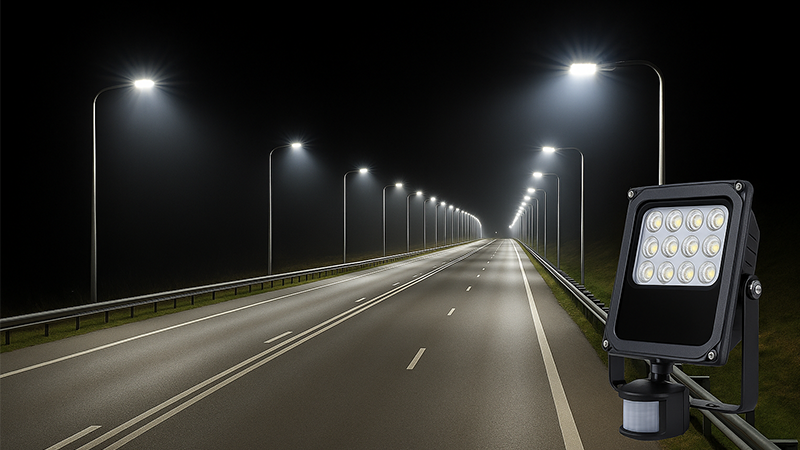
It’s easy to think that making a road safer is just about making it brighter. But the technology behind modern LEDs goes much deeper than that. The way they produce and direct light is what truly transforms a dark road into a safe passage. As a manufacturer, I’ve seen firsthand how the right specifications can make all the difference.
Let’s break down exactly how these lights make our roads safer and what you, as a professional, need to look for when sourcing them.
What are the benefits of LED street lighting?
Managing high energy bills and maintenance for city lighting is a constant budget headache. These costs drain funds from other essential services. LED street lighting cuts energy use and lasts for years.
The main benefits of LED street lighting are massive energy savings, a much longer lifespan, and far lower maintenance costs. They also provide superior light quality, are more durable, and turn on instantly. This makes them a smarter and more reliable choice for any public lighting project.
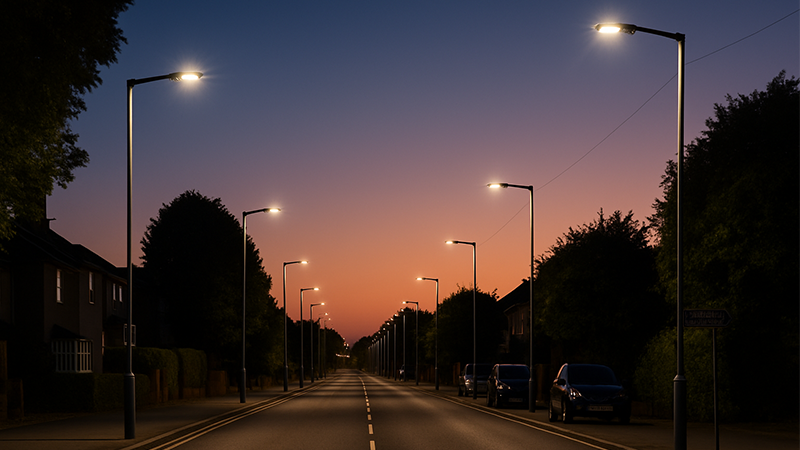
When I started in this industry, High-Pressure Sodium (HPS) lights were the standard. They were cheap to buy but expensive to run. Moving to LED technology has been a game-changer for my clients. The benefits are not just small improvements; they represent a fundamental shift in how we approach public lighting. It’s a change that delivers value across the board, from the finance department to the maintenance crews and, most importantly, the public.
A Closer Look at the Advantages
The advantages of LEDs over traditional lighting sources like HPS or Metal Halide (MH) are significant. It’s not just one thing; it’s a collection of key improvements that work together. As a purchasing manager, understanding these specific differences is crucial for making an informed decision. I always tell my clients to look beyond the initial purchase price and consider the total cost of ownership.
Here’s a direct comparison:
| Feature |
Traditional Lighting (HPS/MH) |
LED Lighting |
| Energy Efficiency |
Low (40-90 lm/W) |
Very High (150 lm/W or more) |
| Lifespan |
Short (10,000-24,000 hours) |
Very Long (50,000-100,000 hours) |
| Maintenance |
Frequent bulb replacements |
Minimal; replace fixtures every 10+ years |
| Color Rendering (CRI) |
Poor (CRI 20-65) |
Excellent (CRI ≥80) |
| Control |
Limited; on/off only |
Full control (dimming, scheduling) |
| Durability |
Fragile bulbs, sensitive to vibration |
Solid-state, highly durable (IK rated) |
The most critical metrics here are efficiency and light quality. An efficacy of 150lm/W means you get more light for every watt of electricity you pay for. A high CRI of 80 or above ensures that colors appear natural. This is a major safety feature. It helps drivers correctly identify road signs, obstacles, and vehicle colors from a distance, giving them more time to react.
Are LED lights good for street lights?
You might hear conflicting reports about LEDs. Some people worry about glare or harsh "blue light." This can make it hard to choose the right lighting for a major public project.
Yes, LED lights are exceptionally good for street lights when they are designed and installed correctly. They offer unmatched efficiency, long life, and superior visibility. By using the right optics and color temperature, they enhance safety far better than any older lighting technology.
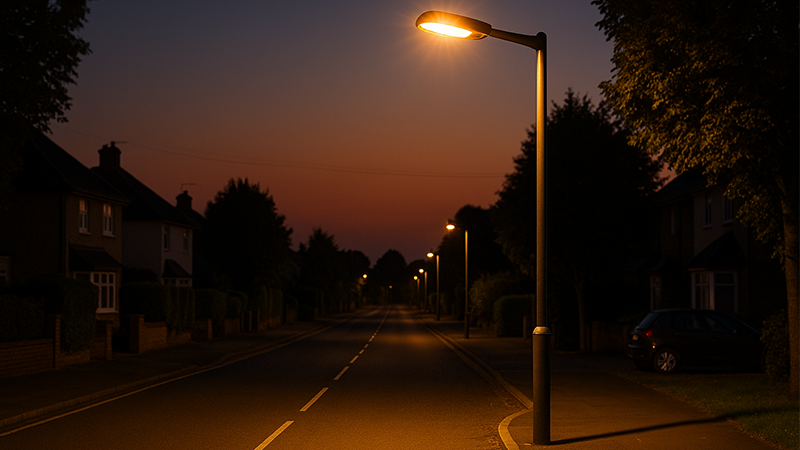
The question isn’t whether LEDs are good, but how we make them good. I’ve seen projects fail because the wrong product was chosen. A cheap, poorly designed LED fixture can create more problems than it solves. But a high-quality, well-engineered fixture is the best solution available today. The key is in the details of the design.
Addressing Common Concerns with Smart Design
Early LED installations sometimes gave the technology a bad name. They were often too bright, too "blue," and created a lot of glare. As manufacturers, we listened to this feedback and learned. Modern LED street lights are designed to solve these exact problems.
1. Controlling Glare:
Glare is stray light that shines into a driver’s eyes, causing discomfort and reducing visibility. This is not a problem with the LED itself, but with the fixture’s optics.
- The Problem: An unshielded LED points light everywhere, including into the sky and at drivers.
- The Solution: We use advanced optical lenses that shape and direct the light precisely. These are called full-cutoff fixtures. They create specific distribution patterns (like Type II for narrow roads or Type III for wider ones) that push all the light down onto the road and sidewalks, where it belongs. I spend a lot of time with my engineers simulating these patterns to ensure our lights improve safety, not harm it.
2. Choosing the Right Color Temperature (CCT):
The concern about "blue light" relates to the color temperature of the light.
- Cool White (5000K-6500K): This light is crisp and blue-toned. It’s excellent for keeping drivers alert on major highways but can feel harsh in residential areas.
- Neutral or Warm White (3000K-4000K): This light is softer and more yellow, similar to traditional bulbs. It is now the standard for neighborhoods and city centers because it’s more comfortable and reduces sky glow.
Choosing the right CCT is about matching the light to the environment. It is not a one-size-fits-all decision.
How bright are LED floodlights?
Choosing the right brightness can feel like a guessing game. Too dim is unsafe, but too bright is just a waste of energy and money. Making the wrong choice leads to failed projects and complaints.
The brightness of LED floodlights is measured in lumens, not watts. A roadway LED can range from 10,000 to over 40,000 lumens. The exact brightness needed is calculated based on the road type, pole height, and required light levels to ensure perfect, efficient illumination.
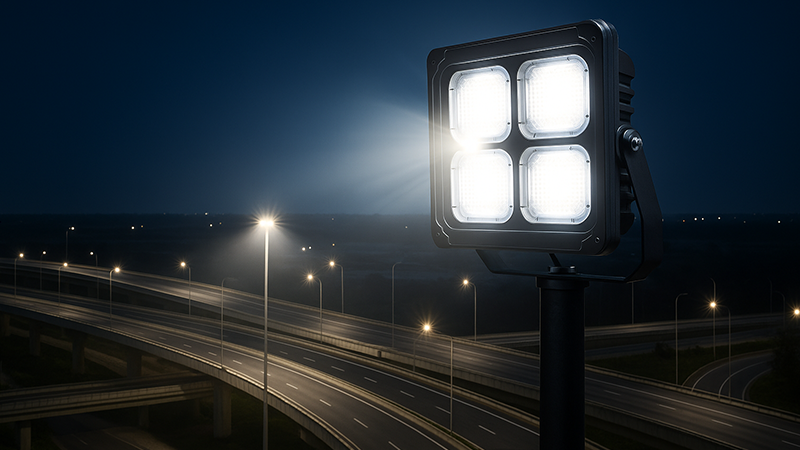
In the past, we all specified lights by wattage. A project called for a "400-watt HPS fixture." Today, that thinking is outdated. Wattage only tells you how much power a light consumes. The true measure of brightness is lumens. This shift is vital for professionals like Shaz to understand when comparing products.
Decoding Brightness: Lumens, Watts, and Efficacy
To specify the right light, you need to understand three related terms: watts, lumens, and luminous efficacy.
- Watts (W): This is the measure of power consumption. It tells you how much electricity the light will use.
- Lumens (lm): This is the measure of the total amount of visible light produced. More lumens means a brighter light.
- Luminous Efficacy (lm/W): This is the most important metric for efficiency. It tells you how many lumens the light produces for every watt of power it consumes. A high-quality fixture today should offer 150 lm/W or more.
Let’s look at how LED replacements stack up against traditional lights. A lower LED wattage can produce the same or even more light.
| Traditional Lamp |
Wattage (Approx.) |
Lumens (Approx.) |
Typical LED Replacement Wattage |
LED Lumens (at 150 lm/W) |
| 250W HPS |
280W |
25,000 lm |
150W |
22,500 lm |
| 400W HPS |
450W |
40,000 lm |
240W |
36,000 lm |
| 1000W MH |
1050W |
85,000 lm |
500W |
75,000 lm |
When I work with a client on a large project, we never just guess the wattage. We run a professional lighting simulation using software like DIALux. This allows us to input the road dimensions, pole heights, and spacing. The software then tells us the exact fixture, lumen output, and optic type needed to meet the official lighting standards for that road. This scientific approach removes all guesswork and guarantees a successful outcome.
How can LEDs be used in traffic lights to improve energy efficiency and visibility compared to traditional incandescent bulbs?
Old traffic lights burn out, use tons of power, and can be impossible to see in bright sunlight. This creates high maintenance bills and extremely dangerous situations at intersections.
LED traffic signals solve all these problems. They use up to 90% less energy and are incredibly visible even in direct sun. Their long life almost eliminates sudden failures, making intersections safer.
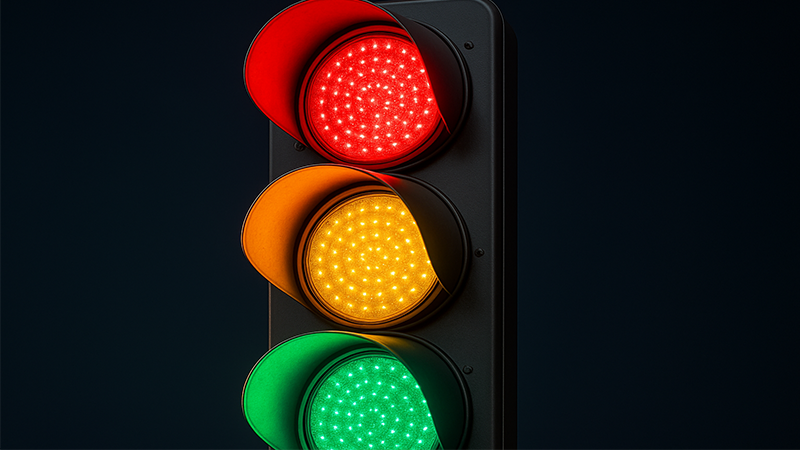
The switch to LEDs in traffic signals is one of the biggest untold stories in roadway safety. While streetlights get a lot of attention, the impact of LEDs at intersections is just as profound. It’s a simple upgrade that delivers huge returns in safety and cost savings. For any city or contractor, this is one of the easiest and most effective upgrades you can make.
The Clear Advantages of LEDs at Intersections
Switching from incandescent bulbs to LED modules in traffic lights is a straightforward process with immediate benefits. The technology is superior in every measurable way.
1. Massive Energy Savings:
This is the most dramatic improvement. An old incandescent traffic signal bulb uses between 60 and 150 watts. A modern LED replacement module uses only 6 to 15 watts. That’s a 90% reduction in energy consumption. I once worked with a city that calculated they were saving thousands of dollars per year at a single intersection after making the switch.
2. Superior Visibility and Safety:
LEDs produce light differently, which makes them safer.
- No "Phantom Effect": On a sunny day, sunlight can reflect off the internal mirror of an old incandescent signal, making it look like it’s on when it’s off. This is known as the phantom effect and is very dangerous. LEDs are directional and don’t use a reflector, so this problem is completely eliminated.
- Daylight Visibility: The light from an LED is pure, saturated color. This intense red, yellow, or green light cuts through sunlight, making the signal clear and unmistakable to drivers at all times.
3. Unmatched Reliability:
Incandescent bulbs have a fragile filament that can break at any moment, causing a sudden, dangerous outage. LEDs are solid-state devices with no filament. They don’t burn out; instead, they slowly dim over an extremely long lifespan.
| Feature |
Incandescent Traffic Light |
LED Traffic Light |
| Power Consumption |
60-150 Watts |
6-15 Watts |
| Lifespan |
~8,000 hours |
50,000-100,000 hours |
| Failure Mode |
Sudden burnout (dangerous) |
Gradual dimming (predictable) |
| Visibility in Sun |
Prone to "phantom effect" |
Clear, no phantom effect |
| Maintenance |
Frequent, unscheduled replacement |
Minimal, planned replacement |
This enhanced reliability means maintenance crews are no longer rushing to fix dark signals. They can plan replacements years in advance, reducing costs and keeping roads safe.
Conclusion
LED floodlights and traffic signals are the clear winner for modern roads. They boost safety with better visibility, slash energy costs, and require far less maintenance than old technologies.